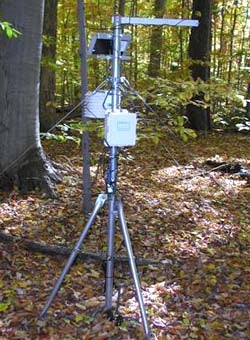Obtain HOBOlink weather data
Primary Forest Weather Station
Location: N 41 29.969, W 81 25.234
Open Field Weather Station
Location: N41 29.813, W81 26.167
Dr. Joseph Koonce, Emeritus Professor of Biology, upgraded the existing weather stations as part of a planned effort to install a high-resolution environmental monitoring network at the farm. The goal is to improve understanding of the interaction of environment and populations of animal and plant species at the scale of the individual organism for research and teaching.
Ultimately, advancing understanding will require high resolution (spatial and temporal) monitoring of key environmental drivers (temperature, relative humidity, light, etc.) and the ability to track animal movements in the environment. There are substantial technical challenges in creating a high-resolution monitoring network, and the upgrade of the existing weather stations is the first step.
With funding from the Oglebay Trust, Dr. Koonce purchased replacement data loggers, replacement precipitation and wind speed/direction sensors, and added new soil moisture sensors. He also purchased four water level data loggers. Solar radiation, temperature, precipitation, and soil moisture are important environmental variables for plants and animals. Individuals respond to these variables and their local gradients in a variety of ways.
The existing weather stations are located in an open field by SOM Road near the east side of the farm and near the permanent plot in the primary forest in the north woodlot by Cedar Road. These two locations represent the extremes in amount of direct solar radiation to flat topography at the farm. These weather stations now have remote data loggers, which report conditions via GSM phone to a Web Server.
Every 12 hours, data is uploaded and archived for interactive use by researchers or students. Probes monitoring incident solar radiation, temperature, relative humidity, precipitation, wind speed, wind direction, and soil moisture are in the open field. In the forest site, probes currently monitor temperature, relative humidity, soil moisture, solar radiation, and wind speed.
In addition to the remote data loggers, a stand-alone data logger for temperature and relative humidity in other forests and open field areas was deployed. The next step will be to deploy water level stand-alone data loggers in Squire Pond, the vernal pool constructed for amphibian habitat in the north woodlot, and the small creek draining the sub-watershed containing the weather stations. In the next expansion phase, the farm will add a remote sensor network to replace the GSM remote data loggers and stand-alone data loggers. This network will consist of a radio base station receiver in the Biology Field Station and a set of radio repeater antennas arrayed over the entire farm. Any number of radio equipped (IEEE 802.15.4, 2.4 GHz ISM band) sensors can be added to this network. The network also will be able to track movement of radio-tagged animals.



